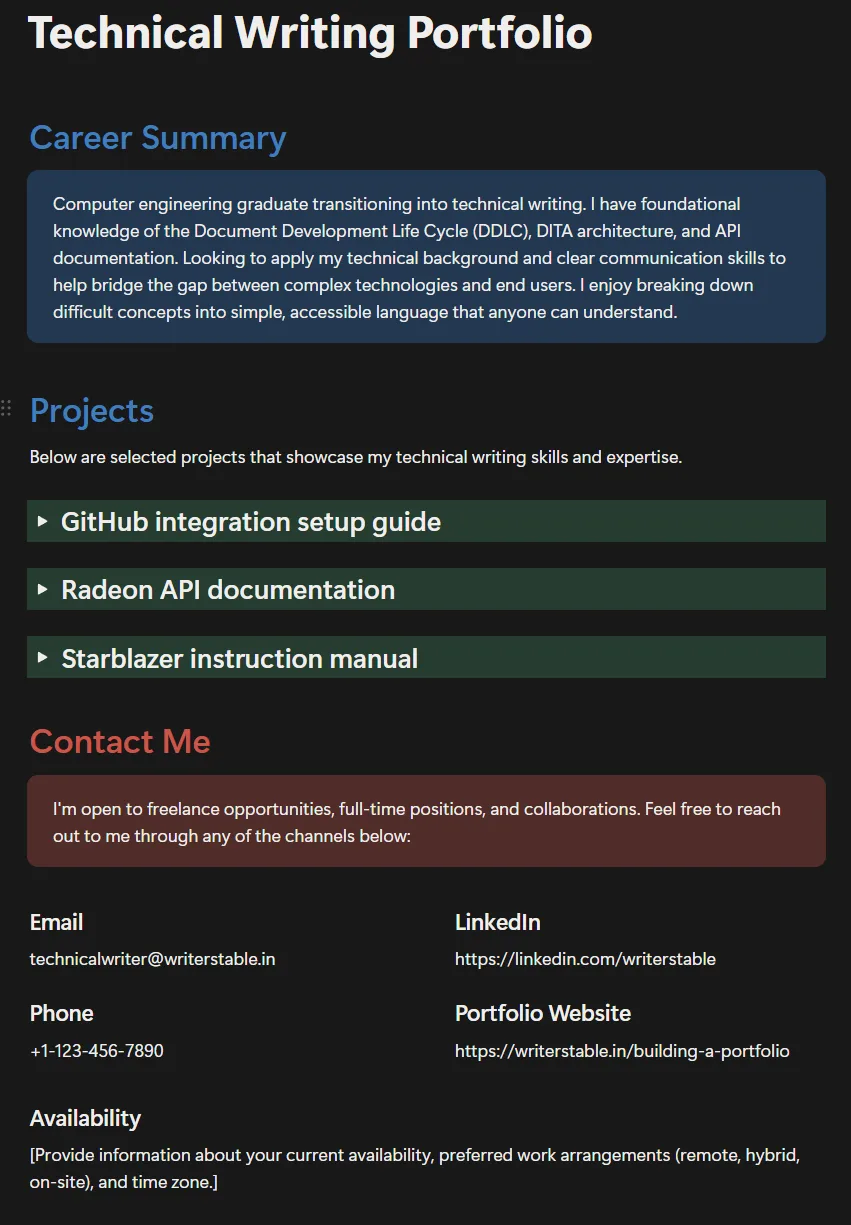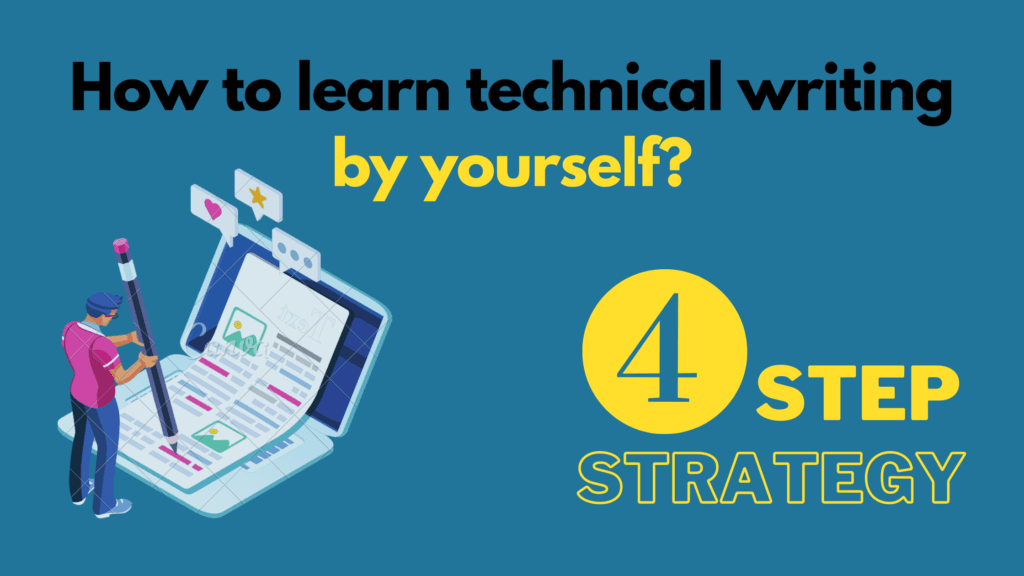What is a technical writing portfolio? What does it look like? How to build a great technical writing portfolio? Let’s answer these questions and more.
While this article focuses primarily on technical writers, the methods described here can still be applied if you are an instructional designer, content writer, or content creator.
Table of Contents
What is a technical writing portfolio?
A technical writing portfolio is a collection of your technical writing work. Whether you are an experienced technical writer or seeking entry into the technical writing field, a portfolio is a great way to showcase your skills as a technical writer. Consider it a calling card. Be it prospective clients (for freelance projects) or organizations you are interviewing at, they will all request to view samples of your work.
What does a technical writing portfolio look like?
A technical writing portfolio can take the shape of a website, a blog, a downloadable PDF, or even a compressed file (not so creatively) titled My_Technical_Writing_Portfolio.zip. Regardless of the format you choose, it should be simple in design, navigable, and highlight your writing samples (and technical writing skills) effectively. You can make it “beautiful” and sophisticated, but keep in mind that it should be easy to refer to by recruiters and clients. Here’s an example of a simple technical writing portfolio design: To learn more about suitable formats for a portfolio, see Online vs Offline formats.

One major obstacle in building a technical communication portfolio
Oftentimes, it is a challenge to show samples of your work because you might be bound by confidentiality agreements. These confidentiality agreements prohibit you from sharing the documentation you created outside the organization. This becomes a pain, especially because prospective clients and organizations request to see samples of your work before they can even consider shortlisting you for a project or an open position.
How then will you show off that excellent information architecture? Those high-resolution, optically similar screenshots? Those extensive glossary entries?
How?!
Here’s how: Easy methods to build your portfolio
What if I told you there are two rather simple methods to build your technical writing portfolio? Keep in mind that both methods require you to work voluntarily (and probably for free):
- Document open-source projects.
- Document the products you use (ideal for beginners).
The first method is more suitable for experienced technical writers. You can use this method even if you are new to technical writing, but it can get overwhelming if it is a complicated project.
Method 1: Build a portfolio by documenting open-source projects
Creating documentation for an open-source project allows you to join and build a network of technical writers and give back to the development community.
Open-source projects are publicly available projects where team members voluntarily contribute their skills and time. The goal is to create a free product for everyone to use, with or without further modifications.
Several open-source projects need capable technical writers. Get in touch with the project stakeholders and volunteer your services. I am sure they would love to have you on board.
I reiterate that this method is not advised for those seeking entry into technical writing or relatively fresh in the field. I say this because there’s usually very little hand-holding, and you are expected to hit the ground running.
My recommended open-source projects
Check out Open Source for open-source projects that are currently available. You can also check out Ubuntu Documentation, Gnome Documentation, and LibreOffice Docs for more such projects. This Reddit post has several open-source projects classified by complexity that you can check out.
Method 2: Build a documentation portfolio by documenting the products you use
Recommended for beginners and entry-level technical writers, this is perhaps the fastest and best method for building a portfolio, as it not only gives you a portfolio you can use but also helps you hone your technical writing skills. I recommend this method for entry-level technical writers because it gives you the freedom to explore various styles of documentation and also enables you to build much-needed confidence in your technical writing skills. Experienced technical writers can also use this method if their published documents are private, internal-circulation only, or blocked by non-disclosure agreements (NDA). Here’s how you can build a documentation portfolio by documenting products you use:
Choose a product
Pick a software, application, or product that you use regularly. Pick one that is common, suitably complex, and related to the type of technical writing you want to demonstrate in the portfolio. For example, Google Drive, MS Office, and GitHub. The product you choose can also correlate to the type of technical writing you’re pursuing. For example, for hardware technical writing: assembling a PC, for medical technical writing: operating an insulin pump.
Review existing documentation
Look at the existing official documentation available for users. You can find this on the product’s official website. For example, Google Drive Help, MS Office Documentation, and GitHub Docs. Your goal is to evaluate the documentation based on usability (structure), readability, and quality, and then find gaps. Since it is a product you already use, you will be able to evaluate the documentation objectively and completely. Maybe the official documentation doesn’t show troubleshooting or administration properly. Maybe the official documentation doesn’t cover edge cases.
Create samples based on your evaluation
Based on your evaluation, recreate an improved version of the documentation. You don’t have to cover every aspect of the product; remember, you’re creating one collection of samples per product. Pick a few features and procedures, and then recreate them to show how you would document them differently. The focus here should be that the samples showcase your ability as a technical writer to simplify complexity. Don’t forget to adopt a style guide so your writing has consistency.
Review, review, and review (and rewrite as needed)
Review each sample meticulously. This ensures that your work doesn’t have any typos and grammatical errors. Multiple rounds of review also help you to shorten large paragraphs or sentences, add modular procedures, and improve navigation. This might seem laborious, but it helps make your writing concise and your documentation effective. Trust me.
Publish your writing sample
When you’re satisfied that the sample is ready to share, publish it as a blog (WordPress or Blogger, both are free). If you prefer publishing it offline, then export PDF versions to a file hosting service like Google Drive or OneDrive.
Update your writing portfolio
Each published piece becomes another addition to your portfolio. You can group them based on the product you documented or the type of manual you created.
Rinse and repeat
Repeat this for at least 3 other products. Keep a diverse list to cover a range of documentation types. Sprinkle in some API documentation (if pursuing software technical writing).
Publicise your documentation portfolio
Share your portfolio on your LinkedIn, Fiverr, Upwork, or Freelancer profiles.
Benefits of the second method
Here are a few benefits of building a technical writing portfolio by documenting the products you use:
Minimal research
Since it’s a product you already use, you will need to spend relatively less time researching the product. You will already know the product’s nuances, bottlenecks, and features. So, the time you would otherwise spend on researching these aspects will be considerably reduced. Thereby leaving you free to focus on creating the content.
Low dependency on SMEs
Extracting information from subject matter experts (SME) is perhaps the biggest challenge a technical writer faces. As the product user, you are the SME! So that eliminates a major challenge and helps you complete the documentation quickly.
3-in-1 advantage
This is the best benefit of this method. You will accomplish the following simultaneously:
- Create the documentation.
- Hone your technical writing and reviewing skills.
- Build confidence in your technical writing skills.
By documenting each product, you are practicing technical writing, sharpening your reviewing and editing skills, becoming more comfortable with the technical writing tools, AND most importantly – building confidence to face interviews! With each subsequent rewrite or edit, you will learn to simplify complex concepts, write concisely, and improve upon your mistakes.
Each successfully documented product adds one more item to your portfolio and gets you a step closer to becoming a full-fledged technical writer!
What to include in a technical writing portfolio?
The portfolio should be structured simply for quick scanning, including a Career Summary (or “About me” section), Projects, Testimonials (optional for beginners), and Contact information. The Projects section is the heart of the portfolio. It must detail each sample’s title, overview (scope, audience, documentation type), and the specific tools and skills (like DDLC or DITA) used. Beginners without professional experience are advised to create sample documentation for products they use daily. It is vital to prioritize quality over quantity, strictly avoiding samples with grammatical or punctuation errors, general instruction manuals for simple tasks (such as tying a shoe), or unrelated graduation essays. While online portfolios are generally easier to maintain, the format should align with recruiter preferences or personal needs. This is covered in detail, including a visual structure, formats, and red flags, in the article What to include in a technical writing portfolio. Check it out!
Key takeaways about building a technical writing portfolio
- A technical writing portfolio is a collection of your technical writing work. It serves as a calling card to showcase your skills as a technical writer.
- Portfolios are requested by prospective clients (for freelance projects) or by organizations during interviews.
- A portfolio can take the shape of a website, a blog, a downloadable PDF, or a compressed file. Both formats have their use.
- Design your portfolio to be simple, easy to navigate, and easy to scan.
- There are two easy methods for building a portfolio: volunteering in open-source projects and documenting products you use.
- Documenting products you use is the fastest way to build a portfolio. Especially for beginners, since there’s minimal research needed. This method also gives you a lot of practice in improving your writing skills.
- Important sections in a writing portfolio: Career summary, Projects (project overview, scope, tools, and skills), Testimonials (if any), and Contact information.
FAQs about building a writing portfolio
How to build a technical writing portfolio with no experience?
A technical writing portfolio trumps a CV if you have no experience. You can create relevant writing samples of any products you use. The more types of samples you create, the better. It helps train your technical writing skills, improves your writing skills, and is usable in your writing portfolio. See this step-by-step guide for a better understanding.
Where to host a technical writing portfolio?
Host your writing portfolio in a WordPress or Blogger blog (to name a few) to make it publicly available. You can also use GitHub if you’re familiar with it. Most experienced technical writers host their portfolio on GitHub. Use file hosting services like Google Drive or OneDrive if you’d rather share it upon request.
What does a technical writing portfolio look like?
A writing portfolio looks similar to your CV, except that it focuses on showcasing your skills instead of your experience. So, it lists projects and writing samples instead of a career history. This way, a writing portfolio becomes a formidable tool for beginners, since they can showcase their skills as a technical writer to recruiters.
How to structure a technical writing portfolio? What to include in it?
While there isn’t a definite formal structure, your portfolio must include a career summary, a list of projects, testimonials, and contact information. Each project listing must include details like overview, intended audience, challenges faced, skills and tools used. See this article to learn more about structuring and designing technical writing portfolios.
Recommended reading
I highly recommend checking the following articles about technical writing portfolios, building successful portfolios, and examples of great technical writing portfolios:
- What to include in a technical writing portfolio
- How to Create a Technical Writing Portfolio
- Top Technical Writing Portfolio Examples 2025
- How to Build a Technical Writing Portfolio and 5 Excellent Examples
- How to Build an Impressive Technical Writing Portfolio from Scratch
- 10 Great Examples Of Technical Writing Portfolios
I hope you found this article helpful. If you didn’t, then I would love to hear from you about what I can do to improve it. For more technical writing-related articles and resources, see the Technical Writing page. Also consider following my YouTube channel learntechnicalwriting, Reddit community r/learntechnicalwriting and Quora space Technical Writer | Technical Writing for more such content.
Affiliate disclaimer: Some of the links in this article are affiliate links. This means that I can get a little commission if you subscribe or make purchases using the link at no extra cost to you.



Pingback: Technical Writing Career FAQs for Beginners | Resources for content creators and technical writers
Should my portfolio change according to the industry?
Ideally, yes. A portfolio must showcase your skill in documenting products. If you are targeting roles in an industry, say Oil and Gas, then the portfolio must showcase your knowledge of OnG standards, itemisation codes, etc.
Pingback: How to learn technical writing by yourself? | Resources for content creators and technical writers
Pingback: How to learn technical writing by yourself? - Writerstable
Pingback: Technical Writing Career FAQs for Beginners - Writerstable